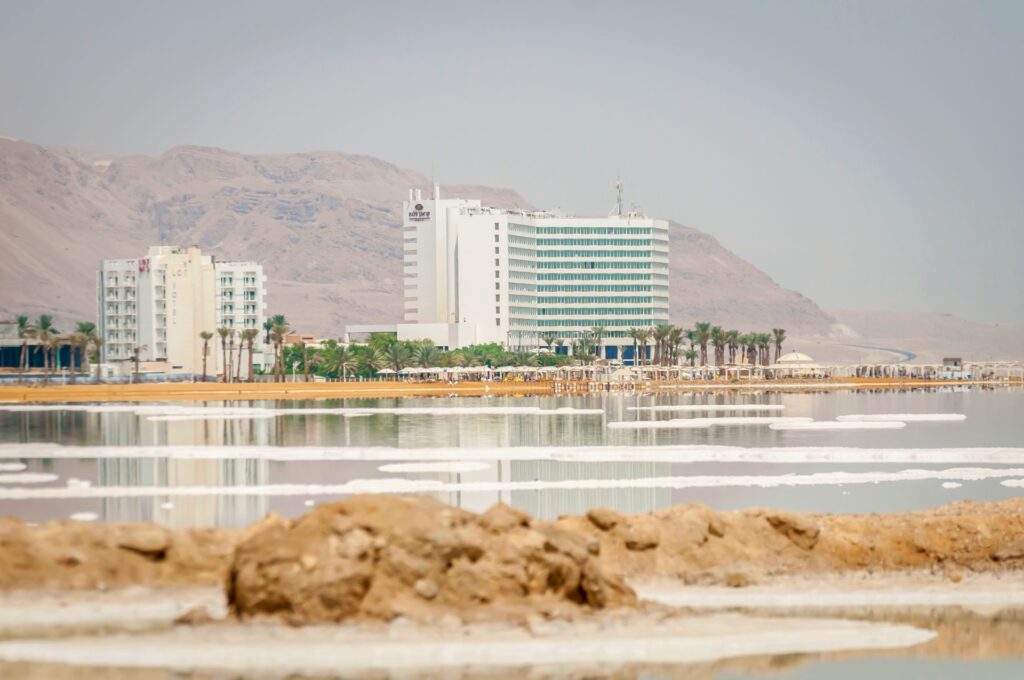The Dead Sea is one of the most beautiful and unique places on the planet. But it is a gem that is dying. Its shoreline is constantly changing—the body of water is shrinking, and it is drying up.
【Tel Aviv INPS Japan=Roman Yanushevsky】

The Dead Sea is a salt lake on the border of Jordan, Israel, and the Palestinian territories. It lies more than 400 meters below sea level, at the lowest point of land on Earth. The water of the Dead Sea has a high salt content, allowing people to float effortlessly. Because of this salinity, there is no life in the lake, which is why it has its name. Therapeutic mud can also be found along its shores.
But it’s visible to the naked eye that, especially in its northern part, the water level continues to drop. In 2015, its area was 810 square kilometers. Now it’s less than 605 square kilometers. Since 1990, the lake’s water level has fallen by more than 30 meters.

Projects for saving the Dead sea are related to a number of the United Nations’ sustainable development goals:
Goal 12 Responsible consumption and production
Goal 13 Climate action
Goal 14 Life below water
Goal 17 Partnerships for the goals
Fortunately, the Dead Sea is located at a point along the Syrian-African Rift, the boundary between two tectonic plates, making it quite deep. However, even so, the receding water harms local unique ecosystems.
On the shores of the Dead Sea, there are insect and plant species that can only thrive at this elevation. As the sea recedes, it erodes the soil and creates sinkholes, large and small—over 1,400 in total.

The dying of the sea is driven not only by climate change but also by human activity. Due to water diversion for agricultural needs, the Jordan River, which flows into the Dead Sea and is one of its main sources, has significantly shallowed. Over the past half-century, the river’s flow has decreased 15-fold, to 100 million cubic meters per year.
Additionally, on the southern shore of the Dead Sea, industries operate that process its waters to extract magnesium, table salt, magnesia, bromine, potassium chloride (potash), and granulated potash. The cosmetics industry is also active in this area, which further impacts the water level.
For many years, experts have proposed various options to save the Dead Sea, but these require international cooperation, which is often hindered by political challenges.
There are at least three projects aimed at supplying water to the Dead Sea.
1. **Northern Route**: This plan involves constructing an open canal from Haifa Bay through Galilee, connecting the Mediterranean Sea to the Dead Sea. The canal would cross a large area with roads, bridges, populated settlements, and agricultural lands.
2. **Central Route**: Engineers propose building a tunnel to link the Mediterranean Sea and the Dead Sea, starting near Ashkelon and passing by Arad down to the Dead Sea. This project was dismissed due to the high cost, as the mountainous terrain with ravines would make construction expensive.
3. **Southern Route**: This plan suggests building a 160-kilometer open canal along with a hydroelectric power plant and tourist infrastructure. Environmentalists opposed this project, as it would disrupt the local ecosystem. This area is a critical stopover for migratory birds traveling to and from Africa.
Another similar project proposes laying a 200-kilometer pipeline from the Red Sea to the Dead Sea, along with the construction of desalination plants and power stations. However, this project faces not only environmental but also political challenges.

Implementing such a project requires close cooperation among Israel, Jordan, and the Palestinian territories. Discussions about it have been ongoing since the mid-1990s, but it has repeatedly been taken off the agenda for political reasons, most recently in 2017. Neighboring Egypt has also expressed concerns, fearing that such a canal could increase earthquake activity in this seismically active region. Egyptians also worry that Israel might use the canal water to cool its nuclear reactor, which they oppose.
As the countries struggle to reach an agreement, the water level in the Dead Sea continues to recede each year, leaving barren land in its wake.
This article is brought to you by INPS Japan in collaboration with Soka Gakkai International in consultative status with ECOSOC.
INPS Japan


